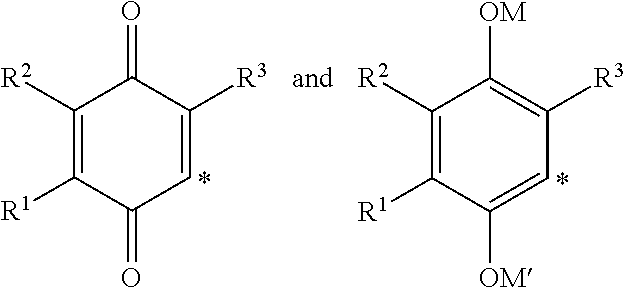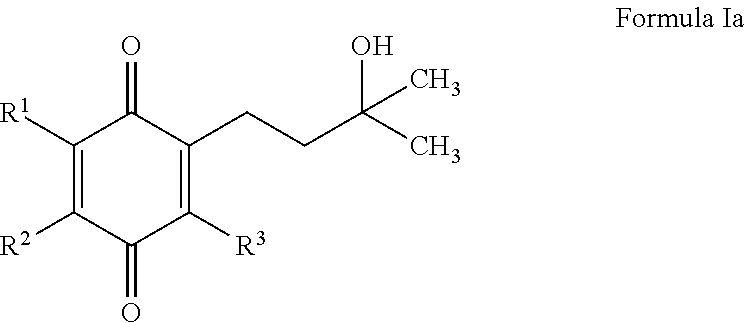(HET)aryl-p-quinone derivatives for treatment of mitochondrial diseases
a technology of arylpquinone and mitochondrial disease, which is applied in the direction of biocide, drug composition, metabolic disorder, etc., can solve the problems of neurological symptoms, the death of almost all aerobic organisms, and the symptoms of tissue or organ dysfunction, so as to improve the health of the patient and raise the level of atp in the individual
- Summary
- Abstract
- Description
- Claims
- Application Information
AI Technical Summary
Benefits of technology
Problems solved by technology
Method used
Image
Examples
example 1
2-(3-Hydroxy-3-methylbutyl)-3,5-dimethyl-6-(4-(trifluoromethyl)phenyl)cyclohexa-2,5-diene-1,4-dione
Step 1: (2,6-Dimethyl-1,4-phenylene)bis(oxy)bis(methylene)dibenzene
[0257]To a stirring solution of 2,6 dimethylhydroquinone (5 g, 36.2 mmol) in 50 mL dimethoxyethane at 23° C. was added a solution of elemental bromine (1.83 mL, 35.8 mmol) in 40 mL dimethoxyethane, dropwise over 75 min. After an additional 15 min, excess bromine was quenched with a 1 M aqueous solution of sodium thiosulfate (25 mL) and the resulting white emulsion was diluted in 150 mL EtOAc and 100 mL 1 M aqueous sodium bicarbonate. The organic layer was washed once with brine, and dried over anhydrous sodium sulfate. The solution was filtered and concentrated in vacuo to a brown solid. The residue was taken up in dimethylformamide (60 mL), and the resulting solution was degassed with Argon for 5 min, after which potassium carbonate (14.5 g, 105 mmol), and benzyl bromide (9.3 mL, 78 mmol) were added rapidly. The result...
example 2
2-(3-Hydroxy-3-methylbutyl)-6-(4-methoxyphenyl)-3,5-dimethylcyclohexa-2,5-diene-1,4-dione
[0261]1H NMR (CDCl3, 400 MHz) 7.07 (m, 3H), 6.93 (d, 2H), 3.82 (s, 3H), 2.59 (m, 2H), 2.09 (s, 3H), 1.96 (s, 3H), 1.55 (m, 2H), 1.25 (s, 6H) ppm.
example 3
4-(5-(3-Hydroxy-3-methylbutyl)-2,4-dimethyl-3,6-dioxocyclohexa-1,4-dienyl)benzonitrile
[0262]1H NMR (CDCl3, 400 MHz) 7.70 (d, 2H), 7.25 (d, 2H), 2.60 (m, 2H), 2.11 (s, 3H), 1.92 (s, 3H), 1.53 (m, 2H), 1.26 (s, 6H) ppm.
PUM
| Property | Measurement | Unit |
|---|---|---|
| temperatures | aaaaa | aaaaa |
| temperatures | aaaaa | aaaaa |
| temperatures | aaaaa | aaaaa |
Abstract
Description
Claims
Application Information
 Login to View More
Login to View More - R&D
- Intellectual Property
- Life Sciences
- Materials
- Tech Scout
- Unparalleled Data Quality
- Higher Quality Content
- 60% Fewer Hallucinations
Browse by: Latest US Patents, China's latest patents, Technical Efficacy Thesaurus, Application Domain, Technology Topic, Popular Technical Reports.
© 2025 PatSnap. All rights reserved.Legal|Privacy policy|Modern Slavery Act Transparency Statement|Sitemap|About US| Contact US: help@patsnap.com



